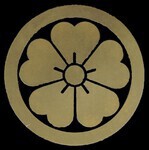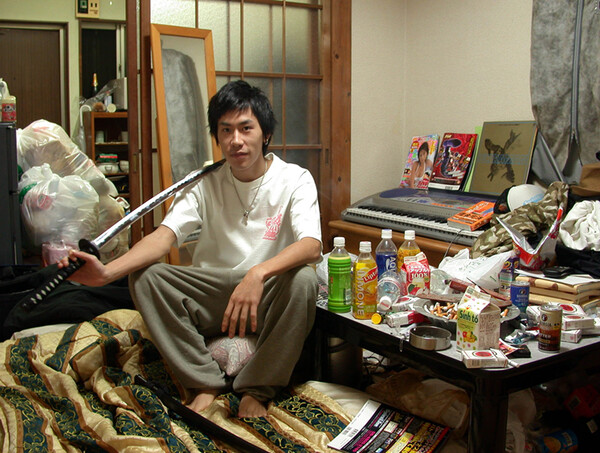-
Posts
3,242 -
Joined
-
Days Won
99
Content Type
Profiles
Forums
Events
Store
Downloads
Gallery
Everything posted by Guido
-
鑑定書 appraisal certificate 作者: 五代 清水六兵衛 maker: 5’th generation Kiyomizu Rokubē 品名: 緑釉盆栽小鉢 product name: green glaze small bonsai pot 重さ約 115 g weight approximately 115 gram つばさ tsubasa (shop name?) (seal) 岩崎 Iwazaki
-
-
-
Ko-kinkō tsuba usually have the nanako applied in parallel lines, not circles, IIRC; I therefore concur with Curran in giving it a Mino attribution, also regarding the overall quality (as opposed to ko-Mino).
-

Showa Stamped Blade From Japan?
Guido replied to vajo's topic in Auctions and Online Sales or Sellers
The law wasn’t changed, it’s just that some toroku-shinsa teams don’t know it fully. So far all licenseses for shōwatō I’ve seen were issued by provincial Boards of Education – like in this case, it’s from Hyōgo prefecture. BTW, IMO the sword in question shows clear signs of being oil quenched; it has a pencil-thin (kind of nioi’ish) habuchi, and the typical ragged peaks. -
The article is a little misleading: yes, the apprenticeship is basically unpaid, but deshi are usually live-in students that get free meals and accommodation, sometimes even some pocket money. Sure, a deshi faces some meager years financially, but it’s not exactly like they have to pay anything out of their own pockets if they are content with the traditional system. Ningen kokuhō smiths, otoh, get a stipend from the government to make it easier for them to take on deshi; it might be a good idea to extend this financial support to mukansa.
-
O.k., got it. Ted is a personal friend of mine, so I was getting a little defensive ...
-
I hope this is just a language problem ...
-
It's just a matter of prioritising things in life. The downside is that I'm hardly able to tie my shoelaces anymore ....
-
If you do a Gogle picture search for 菖蒲革 shōbugawa, it shows many examples of those iris patterns - and none lead to any Christian symbolism, hidden or otherwise: https://www.google.de/search?biw=1760&bih=908&tbm=isch&sa=1&ei=F6gwWs6AIsKr0ASL6r3wBg&q=%E8%8F%96%E8%92%B2%E9%9D%A9&oq=%E8%8F%96%E8%92%B2%E9%9D%A9&gs_l=psy-ab.12..0.61060.64858.0.67914.4.4.0.0.0.0.233.519.2j1j1.4.0....0...1c.1j2.64.psy-ab..0.1.232....0.brp42DrxIEY The iris is often seen as a decoration on Japanese items because its leaves look like sword blades; this plant is even called "Schwertlilie" in German, i.e. "sword lily".
-
And btw, that retention hook is usually only called kaeri 返り, but also kaeritsuno 返り角 or kaeshitsuno 返し角 if made of horn.
-
The inserts are made of the same stenciled deer leather (egawa 絵革) that was used for the trimming of armor. This particular pattern is called yokoshōbu 横菖蒲 and depicts stylized irises.
-
I see. But I hope that for the work on your swords you'll choose someone properly trained and reliable.
-
Ah, so you're dressing a Kinmichi/Kanemichi daishō! I was desperately looking for a hint in your photo as to where you bought the same, but I only can make out "Yoshida" on the bag the electric drill? heat gun? is stored in ... Anyhow, and while I’m at it (and having some time on my hands), here are the 蛇腹糸巻 jabaraitomaki styles I know of: 諸捻り巻 morohinerimaki 組上巻 kumiagemaki 綿縒り細糸組上巻 menyorihosoi- kumiagemaki 鷹の羽違い組上巻 takanohachigai-kumiagemaki 網代組上巻 ajiro-kumiagemaki 菱目組上巻 hishime-kumiagemaki 絡組上巻 karame-kumiagemaki 葵結菱目組上巻 aoikarame-kumiagemaki 亀甲菱葵結 kikkōhishimusubikarame-kumiagemaki I hope I got the transliteration correctly, but in any case, if you copy and paste the Japanese into Google, and do a picture search, the different styles should show up. And since you presented me with the riddle of identifying the store, I hope you're now utterly confused in regard to which style you should choose ...
-
Are you referring to (made by) Kinmichi swords, or a certain type of jabaramaki (because I don't know of any by that name)? Other than that, nice same; it isn't bleached to death like so many other skins (which make them look like kind of plastic). May I ask where you got it?
-

Nihonto & Fireplaces - A Bad Idea?
Guido replied to TheGermanBastard's topic in General Nihonto Related Discussion
The NBTHK keeps swords at about 21° Centigrade and below 55% RH - both in storage and on display, both swords and koshirae. -
http://www.militaria.co.za/nmb/topic/24228-help-translating-mei/
- 1 reply
-
- 1
-

-

Polisher Marks Under The Habaki
Guido replied to Hoshi's topic in General Nihonto Related Discussion
They are there to ease the transition from polished blade to unpolished tang, to make it less abrupt. There might be differences between polishing schools; the Honami use 7 lines IIRC. -
Then we met at Mr. Kurokawa's party? If not, he has some twin walking around Tokyo (or my memory is completely going down the drain, which I can't rule out ... ).
-
I met him briefly at the latest DTI, but never have seen his work in person: http://www.Japanese-sword.it/
-
王處一 Wáng Chùyī (Japanese: 王処一 Ō Shoitsu)
-
The last two characters of the mei are 景光 Kagemitsu, I think, i.e. the name of the smith - the three characters above that elude me. The characters in red lacquer look like 一五八, 158.
-

2018 - Dti Show Dates
Guido replied to GARY WORTHAM's topic in Sword Shows, Events, Community News and Legislation Issues
In his defense, he's one of those hikikomori who never leaves his room, so he didn't see that the 2018 DTI dates are displayed in huge neon signs on Tokyo Tower. -

Movie Sword (Merry Christmas Mr. Lawrence)
Guido replied to vajo's topic in Military Swords of Japan
Some years ago I watched a documentary on Japanese tv about how costumes, wigs, swords, and other movie props for jidai-geki are made. The sword “blades” were made of wood (basically tsunagi), covered with kind of an aluminum foil, the “hamon” (if any) drawn in clear lacquer. A lot of work went into the koshirae, though, looking pretty convincing. I remember that they also talked about a director (forgot the name, b/w movie era shortly after the war) who insisted on real swords in his movies, but that didn’t last for long; he had a hard time finding actors who were willing to work with him, and finally the union interfered.




